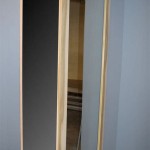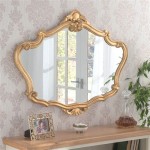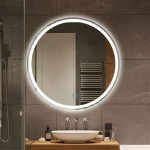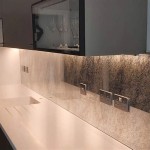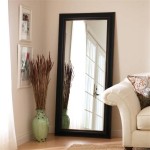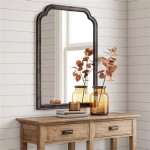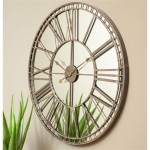How To Hang a Frameless Mirror Without Nails
Hanging a frameless mirror without nails offers a damage-free solution for renters and homeowners who prefer to avoid holes in their walls. Several effective methods provide secure hanging options for various mirror sizes and weights. Choosing the appropriate method depends on the mirror's dimensions, weight, and the wall's material.
1. Adhesive Mirror Mounting Clips
Mirror mounting clips designed specifically for frameless mirrors offer a robust and straightforward installation process. These clips typically come in sets of four or more and utilize a strong adhesive backing to attach directly to the wall and the mirror's back. Before applying the clips, thoroughly clean both the wall surface and the back of the mirror with isopropyl alcohol to ensure optimal adhesion. Carefully measure and mark the desired mirror placement on the wall and align the clips accordingly. Once the clips are firmly attached, carefully position the mirror onto the clips, ensuring it's level and secure.
2. Double-Sided Mounting Tape
For lighter frameless mirrors, heavy-duty double-sided mounting tape can provide a sufficient hold. Select a tape specifically designed for mirrors and heavy objects, ensuring it's compatible with the wall's material. Like with adhesive clips, preparing the surfaces is crucial. Clean both the wall and the mirror's back with isopropyl alcohol to remove any dust, dirt, or residue. Apply the tape in vertical strips to the back of the mirror, leaving a small gap between each strip to allow for air expansion. Carefully peel off the protective backing from the tape and align the mirror onto the marked position on the wall. Apply firm, even pressure for several seconds to ensure a strong bond.
3. Mirror Mastics
Mirror mastic is a specialized adhesive designed for bonding mirrors to various surfaces, including walls. This method is suitable for medium to large-sized frameless mirrors and offers a strong, permanent bond. Before applying the mastic, ensure the wall is clean and dry. Follow the manufacturer's instructions for application, which typically involves applying dabs of mastic to the back of the mirror in a grid pattern. Carefully position the mirror onto the wall and apply even pressure. Temporary supports, like painter's tape or small wooden blocks, may be necessary to hold the mirror in place while the mastic cures, which can take several hours or even days depending on the product.
4. Suction Cup Hangers
Suction cup hangers offer a removable and reusable option for hanging lightweight frameless mirrors, especially in bathrooms or other areas where moisture resistance is important. These hangers typically consist of two or more suction cups with hooks or clips that attach to the mirror. Ensure the wall and the mirror's back are clean and dry before applying the suction cups. Press the suction cups firmly onto the wall, ensuring a secure seal. Then, hang the mirror onto the hooks or clips. Regularly check the suction cups for firmness and reapply them if necessary, especially in humid environments.
5. J-Channels
J-channels provide a sleek and discreet method for hanging frameless mirrors, especially larger or heavier ones. These metal or plastic channels are mounted to the wall, and the mirror is then slid into the channel from the top or side. This method offers a secure hold and allows for minor adjustments to the mirror's position. Accurate measurements are crucial for proper J-channel installation. Secure the channels to the wall using appropriate fasteners, ensuring they are level and aligned correctly. Carefully slide the mirror into the channel until it's fully seated and secure.
6. Combination Methods
For extremely heavy or large frameless mirrors, combining methods, such as using adhesive clips in conjunction with mirror mastic, can provide added security. This layered approach distributes the weight more evenly and enhances the overall hold. When combining methods, always consider the weight limitations of each individual method and ensure their compatibility.
7. Considerations for Different Wall Materials
The wall material plays a significant role in selecting the appropriate hanging method. For drywall, most methods are suitable, but heavier mirrors may require stronger adhesives or mechanical fasteners used in conjunction with adhesive methods. For tiled walls, avoid using adhesive methods directly on the grout lines. Instead, focus on applying adhesives or fasteners to the solid tile surface. For textured walls, adhesive methods may not adhere effectively. In these cases, mechanical fasteners or specialized adhesive systems designed for textured surfaces may be necessary. Always test the chosen method on an inconspicuous area of the wall before applying it to the entire mirror.

3 Simple Ways To Hang A Mirror On Wall Without Nails Wikihow

3 Simple Ways To Hang A Mirror On Wall Without Nails Wikihow

3 Simple Ways To Hang A Mirror On Wall Without Nails Wikihow

3 Simple Ways To Hang A Mirror On Wall Without Nails Wikihow

How To Hang A Hanging Mirror Without Accompanying Hardware

3 Simple Ways To Hang A Mirror On Wall Without Nails Wikihow

How To Hang A Mirror On Wall Without Nails

How To Hang A Mirror On Wall Without Nails Guide For All Diyers

How To Hang A Frameless Mirror On The Wall With Pictures

How To Hang A Heavy Mirror Without Nails Worst Room

